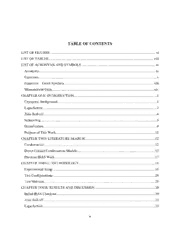
NASA Technical Reports Server (NTRS) 20100036659: Experimental Studies of Liquefaction and Densification of Liquid Oxygen PDF
Preview NASA Technical Reports Server (NTRS) 20100036659: Experimental Studies of Liquefaction and Densification of Liquid Oxygen
EXPERIMENTAL STUDIES OF LIQUEFACTION AND DENSIFICATION OF LIQUID OXYGEN by JONATHAN KOERT PARTRIDGE B.S. Tennessee Technological University, 2003 A thesis submitted in partial fulfillment of the requirements for the degree of Master of Science in Mechanical Engineering in the Department of Mechanical, Materials, and Aerospace Engineering in the College of Engineering and Computer Science at the University of Central Florida Orlando, Florida FallTerm 2010 The following is the result of research completed as a portion of the author’s duties as an employee of the National Aeronautics and Space Administration. This work is hereby declared a work of the government and not subject to copyright within the United States of America. ii ABSTRACT The propellant combination that offers optimum performance is very reactive with a low average molecular weight of the resulting combustion products. Propellant combinations such as oxygen and hydrogen meet the above criteria, however, the propellants in gaseous form require large propellant tanks due to the low density of gas. Thus, rocketry employs cryogenic refrigeration to provide a more dense propellant stored as a liquid. In addition to propellant liquefaction, cryogenic refrigeration can also conserve propellant and provide propellant subcooling and propellant densification. Previous studies analyzed vapor conditioning of a cryogenic propellant, with the vapor conditioning by either a heat exchanger position in the vapor or by using the vapor in a refrigeration cycle as the working fluid. This study analyzes the effects of refrigeration heat exchanger located in the liquid of the common propellant oxidizer, liquid oxygen. This study predicted and determined the mass condensation rate and heat transfer coefficient for liquid oxygen. ii ACKNOWLEDGEMENTS The author acknowledges Jeff Tuttle, Kevin Jumper, Brian Hunter, Matt Nugent, Gary Wall, Jeff Wall, Bill Notardonato, and Wesley Johnson for their contributions to the design, operation, management, and consultation of IRAS data analysis and evaluation. iii TABLE OF CONTENTS LIST OF FIGURES..................................................................................................................vi LIST OF TABLES..................................................................................................................viii LIST OF ACRONYMS AND SYMBOLS................................................................................ix Acronyms..............................................................................................................................ix Equations.................................................................................................................................x Equations – Greek Symbols.................................................................................................xiii Measurement Units...............................................................................................................xiv CHAPTER ONE: INTRODUCTION..........................................................................................1 Cryogenic Background............................................................................................................1 Liquefaction............................................................................................................................3 Zero Boil-off...........................................................................................................................4 Subcooling..............................................................................................................................8 Densification...........................................................................................................................9 Purpose of This Work............................................................................................................11 CHAPTER TWO: LITERATURE SEARCH............................................................................12 Condensation.........................................................................................................................12 Direct Contact Condensation Models.....................................................................................12 Previous IRAS Work.............................................................................................................17 CHAPTER THREE: METHODOLOGY...................................................................................18 Experimental Setup...............................................................................................................18 Test Configurations...............................................................................................................24 Test Matrices.........................................................................................................................28 CHAPTER FOUR: RESULTS AND DISCUSSION.................................................................30 Initial IRAS Checkout...........................................................................................................30 Zero Boil-off.........................................................................................................................34 Liquefaction..........................................................................................................................35 iv Densification.........................................................................................................................41 APPENDIX A: HEAT TRANSFER ANALYSIS......................................................................42 Heat Transfer Analysis Through Teflon Insulation................................................................43 Heat Transfer Analysis for IRAS Heat Exchanger .................................................................50 APPENDIX B: EXPERIMENTAL SETUP INFORMATION...................................................52 APPENDIX C: FLUID COMPOSITION..................................................................................56 Nitrogen................................................................................................................................57 Oxygen..................................................................................................................................58 Helium..................................................................................................................................59 APPENDIX D: HEAT TRANSFER COEFFICIENT DERIVATION........................................60 Direct Contact Condensation by Vapor Collapse ...................................................................61 Direct Contact Condensation by Bubble Collapse..................................................................64 APPENDIX E: OXYGEN AND NITROGEN PROPERTY CORRELATIONS........................67 Oxygen Vapor Pressure.........................................................................................................68 Oxygen Vapor Heat Capacity................................................................................................69 Oxygen Vapor Density..........................................................................................................70 Oxygen Latent Heat...............................................................................................................71 Liquid Oxygen Density..........................................................................................................73 Liquid Oxygen Thermal Conductivity....................................................................................74 Liquid Oxygen Viscosity.......................................................................................................75 Liquid Oxygen Surface Tension............................................................................................76 Nitrogen Vapor Pressure........................................................................................................77 NitrogenVapor Heat Capacity...............................................................................................78 Nitrogen Latent Heat.............................................................................................................79 Liquid Nitrogen Density........................................................................................................80 Helium Solubility in Liquid Oxygen......................................................................................81 APPENDIX F: SAMPLE CALCULATIONS............................................................................82 REFERENCES.........................................................................................................................91 v LIST OF FIGURES Figure 1: Cryogenic Refrigerationand Rocketry Use ..................................................................2 Figure 2: Experimental Setup - Simplified Process Instrumentation Diagram............................18 Figure 3: Cross-Section of IRAS Dewar and Male Bayonet.......................................................20 Figure 4: Liquid Nitrogen Subcooler.........................................................................................22 Figure 5: IRAS Energy Balance................................................................................................24 Figure 6: Subdivided IRAS Energy Balance..............................................................................25 Figure 7: IRAS Heat Exchanger Leak Check.............................................................................32 Figure 8: Temperature Profile of IRAS Containing Liquid Oxygen...........................................33 Figure 9: Convection Currents within IRAS Dewar during Top Fill Liquefaction......................36 Figure 10: Cooling Rate at Constant Oxygen Flow Rate and Pressure.......................................37 Figure 11: Equation 1 Results from Test Run 3a through Test Run 3l........................................38 Figure 12: Equation 3 Results for Test Run 3a through Test Run 3l...........................................38 Figure 13: Equation 6 Results for Test Run 3a through 3l..........................................................39 Figure 14: Convection Currents within IRAS Dewar during Bottom Fill Liquefaction...............40 Figure 15: Fill and Vent Tubing Thermal Resistance Model......................................................43 Figure 16: Fill Tube Insulation Optimization.............................................................................49 Figure 17: Vent Tube Insulation Optimization...........................................................................49 Figure 18: IRAS Heat Exchanger..............................................................................................50 Figure 19: IRAS Heat Exchanger Cross-Section........................................................................50 Figure 20: Experimental Setup - Detailed Process Instrumentation Diagram..............................53 Figure 21: Heat Transfer Coefficient Derivation Model.............................................................61 Figure 22: Oxygen Latent Heat.................................................................................................71 Figure 23: Liquid Oxygen Heat Capacity..................................................................................72 Figure 24: Liquid Oxygen Density............................................................................................73 Figure 25: Liquid Oxygen Thermal Conductivity......................................................................74 Figure 26: Liquid Oxygen Viscosity..........................................................................................75 vi Figure 27: Liquid Oxygen Surface Tension...............................................................................76 Figure 28: Nitrogen Latent Heat................................................................................................79 Figure 29: Liquid Nitrogen Density...........................................................................................80 vii LIST OF TABLES Table 1: Experimental Setup - Simplified Process Instrumentation Diagram Legend.................19 Table 2: IRAS Energy Balance Definitions...............................................................................24 Table 3: Subdivided IRAS Energy Balance Definitions.............................................................25 Table 4: Test 2 Matrix – Zero Boil-off......................................................................................28 Table 5: Test 3 Matrix – Liquefaction.......................................................................................28 Table 6: Test 4 Matrix – Densification......................................................................................29 Table 7: Experimental Setup - Detailed Process Instrumentation Legend...................................54 Table 8: Nitrogen Procurement Specification and Laboratory Analysis.....................................57 Table 9: Oxygen Procurement Specification and Laboratory Analysis.......................................58 Table 10: Helium Procurement Specification and Laboratory Analysis .....................................59 viii LIST OF ACRONYMS AND SYMBOLS Acronyms ARC NASA – Ames Research Center GHe Gaseous Helium GN Gaseous Nitrogen 2 GO Gaseous Oxygen 2 IRAS Integrated Refrigeration and Storage KSC NASA – Kennedy Space Center LC Launch Complex LN Liquid Nitrogen 2 LO Liquid Oxygen 2 MAWP Maximum Allowable Working Pressure MRI Magnetic Resonance Imaging NASA National Aeronautics and Space Administration NASP National Aerospace Plane ZBO Zero Boil-off ix
